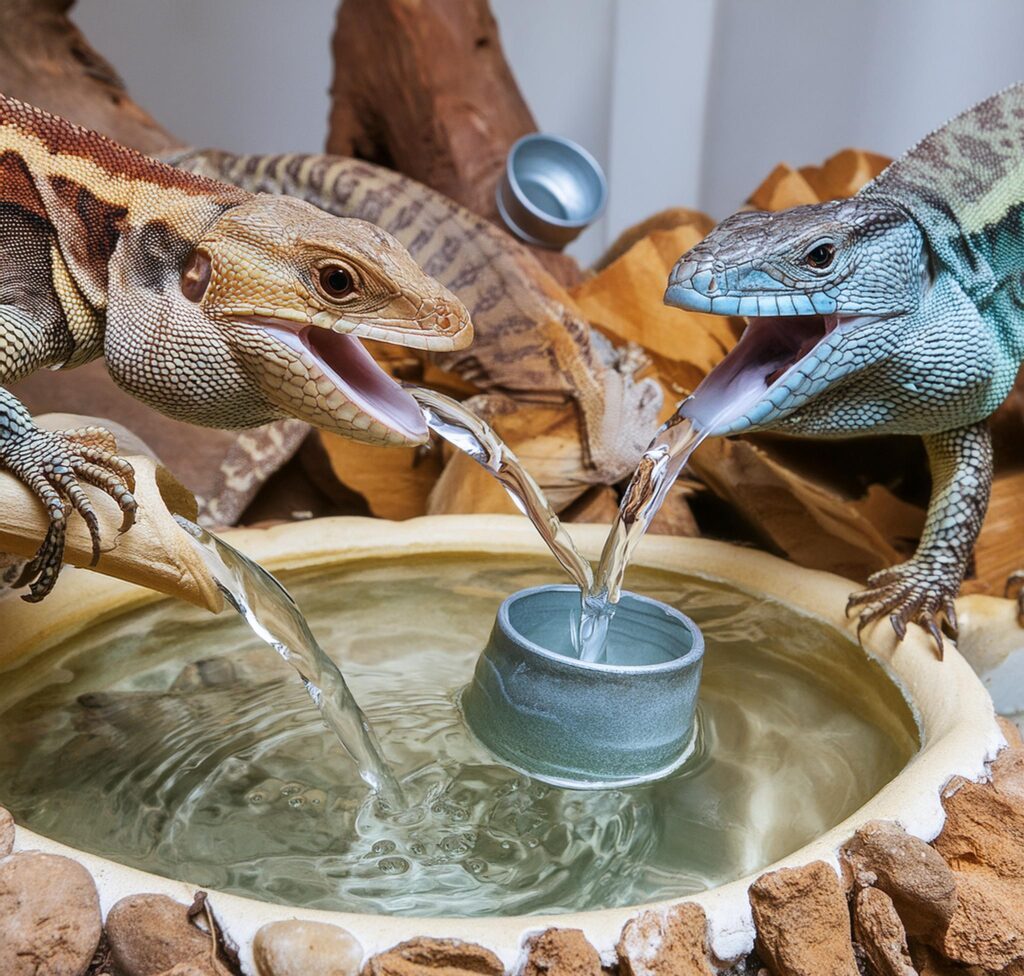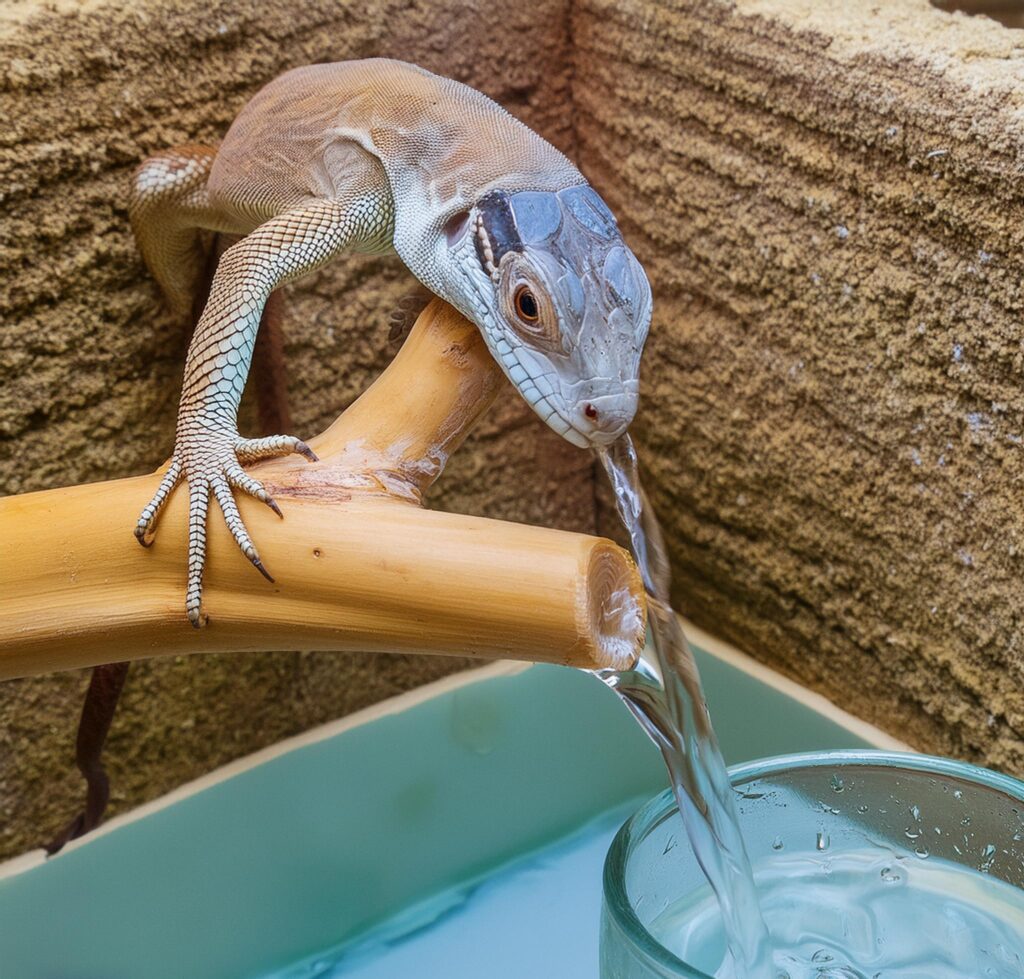The Role of Water Features in Reptile Enclosures

Introduction
Reptiles are fascinating creatures that require specific habitats to thrive in captivity. In order to recreate their natural environments, it’s essential to include water features in their enclosures. Water plays a crucial role in the overall well-being of reptiles, providing them with hydration, opportunities for exercise, and an environment that simulates their natural habitat.
Why water features are important for reptiles
Water features are important for reptiles for several reasons. Firstly, water sources provide reptiles with hydration, allowing them to maintain their overall health. Reptiles have unique physiological needs, and access to water is essential for their survival. Water features in their enclosures ensure that they have a constant supply of clean and fresh water to drink.
Additionally, water features also play a crucial role in regulating the body temperature of reptiles. Reptiles are ectothermic, meaning they rely on external sources of heat to regulate their body temperature. By having a water feature in their enclosure, reptiles can thermoregulate by either basking in the sun or cooling off in the water. This ability to control their body temperature is vital for their overall health and well-being.
Lastly, water features in reptile enclosures provide opportunities for exercise and enrichment. Many reptiles, such as turtles and semi-aquatic species like green tree pythons or water dragons, are naturally inclined to swim and explore aquatic environments. By providing them with a water feature, reptiles can engage in natural behaviors, which promotes physical activity and mental stimulation.
Types of water features for reptile enclosures
When it comes to choosing the right water feature for a reptile enclosure, there are several options to consider. The type of water feature you select will depend on the specific needs and preferences of your reptile. Here are a few popular choices:
- Ponds: Ponds are larger water features that can provide ample space for reptiles to swim and explore. They can be customized with aquatic plants and rocks to create a more naturalistic environment. Ponds are particularly suitable for larger reptiles or those that require a spacious aquatic habitat.
- Pools: Pools are smaller water features that can be easily incorporated into reptile enclosures. They are ideal for reptiles that require a shallow water source for soaking and drinking. Pools can be designed with ramps or steps to provide easy access for reptiles to enter and exit the water.
- Shallow dishes: Shallow dishes are simple and cost-effective water features that can be used for smaller reptiles or those that prefer a more confined water source. These dishes can be filled with fresh water regularly and placed in different areas of the enclosure to provide variety for the reptile.
How to choose the right water feature for your reptile
Choosing the right water feature for your reptile is crucial to ensure their comfort and well-being. Here are some factors to consider when selecting a water feature:
- Species-specific needs: Different reptile species have different requirements when it comes to water. Research the specific needs of your reptile to determine the size, depth, and type of water feature they require. Some reptiles may prefer a larger aquatic habitat, while others may only need a small water dish.
- Enclosure size: Consider the size of your reptile’s enclosure when choosing a water feature. Ensure that the water feature does not take up too much space and allows for adequate movement and basking areas. It’s important to strike a balance between the water feature and other elements within the enclosure.
- Maintenance: Consider the maintenance requirements of the water feature. Larger water features such as ponds may require more upkeep, including filtration systems and regular water changes. Ensure that you have the resources and time to properly maintain the water feature to keep it clean and safe for your reptile.
Setting up and maintaining a water feature in a reptile enclosure
Setting up and maintaining a water feature in a reptile enclosure requires careful planning and attention to detail. Here are some steps to follow:
- Proper placement: Determine the best location for the water feature within the enclosure. Consider factors such as temperature, lighting, and accessibility for the reptile. Ensure that the water feature is easily accessible but also allows for enough dry areas for basking.
- Water quality: Use clean and dechlorinated water for the water feature. Reptiles are sensitive to chemicals and impurities in the water, so it’s important to provide them with a safe and suitable water source. Regularly test the water quality and make any necessary adjustments to ensure optimal conditions.
- Filtration and cleaning: Depending on the size and type of water feature, you may need to install a filtration system to keep the water clean and free from debris. Regularly clean the water feature, removing any waste or algae buildup. This will help maintain a healthy and hygienic environment for your reptile.
Benefits of water features for reptile health and well-being
Water features in reptile enclosures offer numerous benefits for the health and well-being of these fascinating creatures. Some of the key advantages include:
- Hydration: Reptiles require access to water for hydration, and water features provide a consistent supply of fresh water for them to drink and soak in.
- Thermoregulation: Water features allow reptiles to regulate their body temperature by providing them with the option to cool off in the water or bask in the sun.
- Exercise and enrichment: Water features promote natural behaviors such as swimming, soaking, and exploring, which provide reptiles with valuable exercise and mental stimulation.
- Visual appeal: Water features add visual interest to reptile enclosures, creating a more naturalistic and aesthetically pleasing environment.

Common mistakes to avoid when using water features in reptile enclosures
While water features can greatly enhance reptile enclosures, there are some common mistakes that should be avoided:
- Inadequate water source: Providing insufficient water or not refilling the water feature regularly can lead to dehydration and health issues for your reptile. Ensure that the water level is always appropriate and monitor your reptile’s water intake.
- Poor water quality: Neglecting to maintain proper water quality can result in bacterial growth, algae buildup, and other waterborne diseases. Regularly test the water and clean the water feature to prevent health issues.
- Unsafe design: Be mindful of the design and construction of the water feature to avoid any potential hazards for your reptile. Ensure that the water feature has easy access points and that it is secure to prevent any accidents or escapes.
Safety precautions for using water features in reptile enclosures
When using water features in reptile enclosures, it’s important to take certain safety precautions to ensure the well-being of your reptile:
- Supervision: Always supervise your reptile when they are in or near the water feature to prevent any accidents or injuries. Keep a close eye on them, especially if they are not strong swimmers or if the water feature is large.
- Water temperature: Monitor the temperature of the water to ensure it is suitable for your reptile. Extreme temperatures can be harmful, so it’s important to provide a comfortable and safe environment.
- Water depth: Consider the water depth based on the size and abilities of your reptile. Ensure that the water is not too deep, especially for smaller or less experienced swimmers.
DIY water feature ideas for reptile enclosures
If you’re feeling creative, here are a few DIY water feature ideas for reptile enclosures:
- Rock waterfall: Create a natural-looking rock waterfall using aquarium-safe rocks and a small water pump. This can provide a visually appealing water feature that mimics the look and sound of a natural stream.
- Misting system: Install a misting system that periodically sprays a fine mist of water into the enclosure. This can simulate rain and provide a source of water for your reptile to drink from.
- Pond with plants: Create a mini-pond using a plastic tub or container. Add aquatic plants, rocks, and a small water filter to create a self-contained ecosystem. This can provide a more naturalistic water feature for your reptile.
Conclusion
By considering the role of water features in reptile enclosures, you can create a more engaging and enriching environment for your reptilian companions. Water features not only provide essential hydration but also promote natural behaviors, exercise, and mental stimulation. When choosing and setting up a water feature, it’s important to consider the specific needs of your reptile and ensure their safety and well-being. With the right water feature, you can create a habitat that closely resembles their natural environment and allows them to thrive in captivity.
Also Read: Enrichment and Mental Stimulation in Captive Reptiles
What do you think?
Show comments / Leave a comment